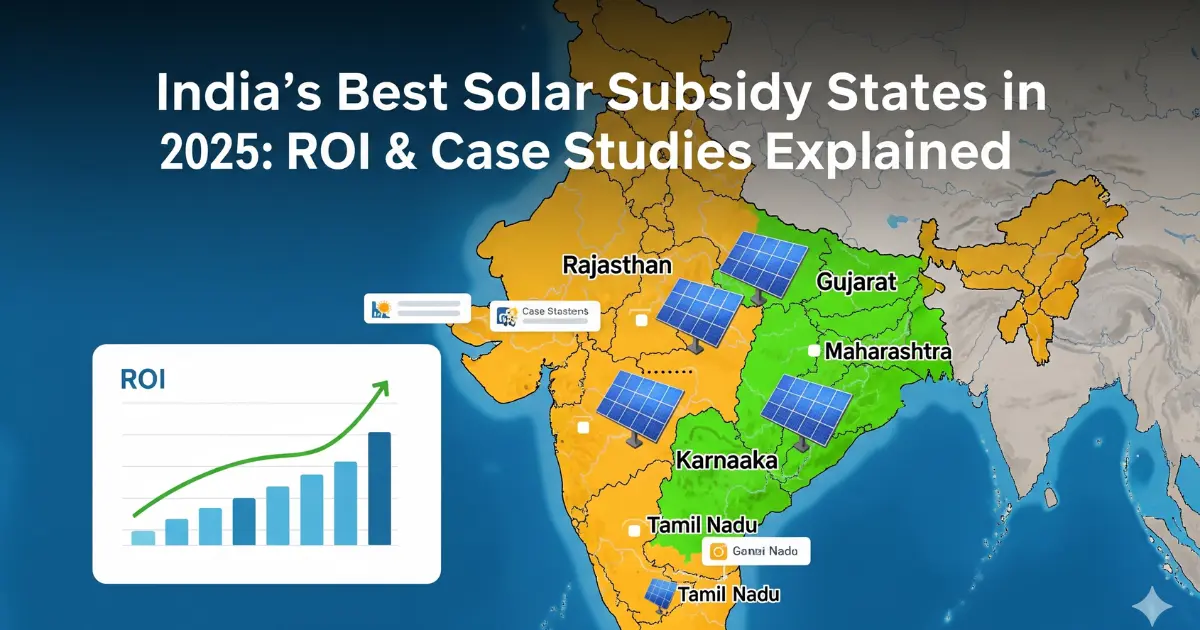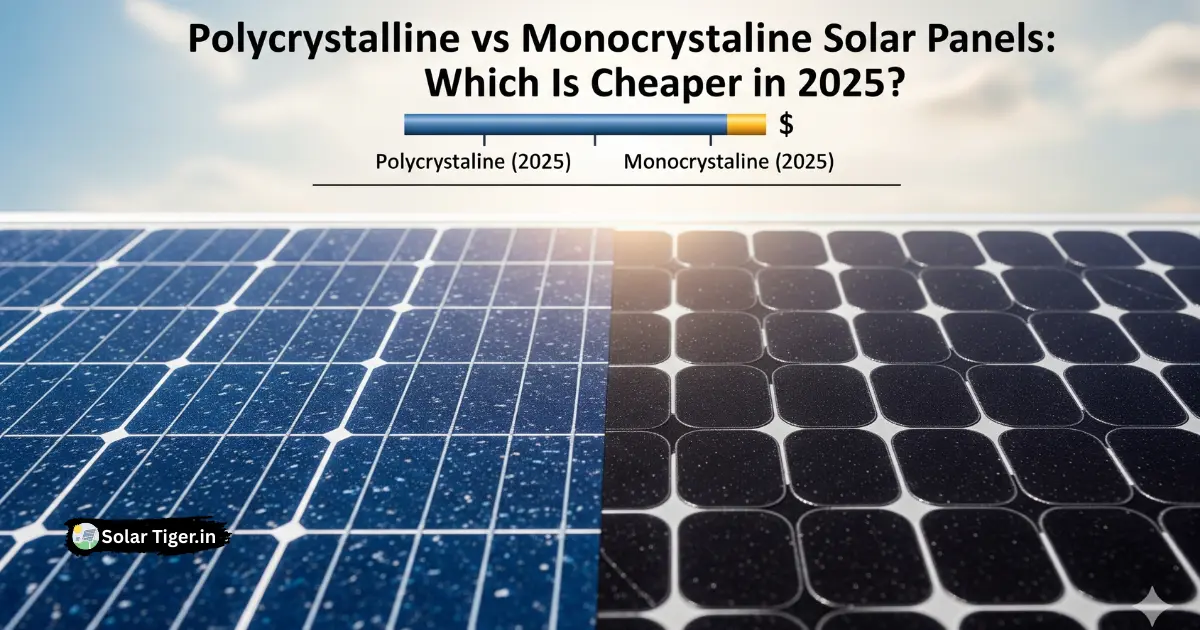Best Solar Subsidy States: India is witnessing a solar revolution. The government’s PM Surya Ghar: Muft Bijli Yojana and various state-level subsidies have made rooftop solar more affordable than ever. In 2025, homeowners can install solar panels at 40–50% lower net cost thanks to central + state support.
But here’s the big question: Which states in India are offering the highest solar subsidy in 2025?
Let’s explore the top 5 states, real-life case studies of households that went solar, and ROI examples to help you decide whether it’s worth investing in solar this year.
Central Subsidy at a Glance (2025)

Before diving into state-specific subsidies, here’s what the central scheme offers under PM Surya Ghar Yojana:
- Up to 2 kW: ₹30,000 per kW
- Above 2–3 kW: ₹18,000 per kW
- Above 3 kW: Flat subsidy of ₹78,000 per household
| Details | Resources |
|---|---|
| Official Website | https://pmsuryaghar.gov.in/ |
This central subsidy is available across India, but some states add extra support, making solar even cheaper.
Top 5 States Offering the Best Solar Subsidy States in 2025
1. Gujarat
Gujarat continues to lead in solar adoption, thanks to its attractive subsidy structure and easy net-metering approvals.
- State Subsidy (2025): Additional ₹10,000–₹20,000 per kW on top of central subsidy (capped at 10 kW).
- Total Benefit: Up to ₹1 lakh for a 5 kW system.
Case Study (Ahmedabad):
The Shah family installed a 5 kW polycrystalline system costing ₹2.4 lakh.
- Central Subsidy: ₹78,000
- Gujarat State Subsidy: ₹20,000
- Net Cost: ₹1.42 lakh
- Savings: ~₹6,000/month
- Payback: ~2 years
2. Delhi (NCT)
The Delhi Solar Policy offers one of the best top-ups in India, combined with the central scheme.
- State Subsidy (2025): ₹2,000 per kW up to 3 kW (max ₹6,000) plus capital incentives under select DISCOMs.
- Total Benefit: Central + state subsidy reduces costs by 35–40%.
Case Study (Dwarka):
Mr. Mehta installed a 3 kW monocrystalline system costing ₹1.7 lakh.
- Central Subsidy: ₹60,000
- Delhi Subsidy: ₹6,000
- Net Cost: ₹1.04 lakh
- Savings: ₹3,500/month
- Payback: ~2.5 years
3. Maharashtra
Maharashtra has introduced targeted subsidies to promote solar among urban and rural households.
- State Subsidy (2025): ₹10,000–₹15,000 per kW up to 3 kW.
- Total Benefit: Families installing small systems save up to 40–45% upfront.
Case Study (Pune):
The Deshmukh family installed a 2 kW system costing ₹1.2 lakh.
- Central Subsidy: ₹36,000
- Maharashtra Subsidy: ₹20,000
- Net Cost: ₹64,000
- Savings: ₹1,800–₹2,000/month
- Payback: ~2.5 years
4. Rajasthan
With high solar potential, Rajasthan offers attractive subsidies to push rooftop solar.
- State Subsidy (2025): ₹10,000 per kW for residential installations up to 3 kW.
- Total Benefit: ₹30,000 on top of central subsidy.
Case Study (Jaipur):
The Sharma family installed a 3 kW system costing ₹1.65 lakh.
- Central Subsidy: ₹60,000
- Rajasthan Subsidy: ₹30,000
- Net Cost: ₹75,000
- Savings: ₹3,000/month
- Payback: ~2 years
5. Haryana
Haryana offers strong financial support under its renewable energy program.
- State Subsidy (2025): ₹15,000 per kW up to 4 kW (max ₹60,000).
- Total Benefit: Families can install solar at 50% less cost.
Case Study (Gurugram):
The Verma family installed a 4 kW monocrystalline system costing ₹2.2 lakh.
- Central Subsidy: ₹78,000
- Haryana Subsidy: ₹60,000
- Net Cost: ₹82,000
- Savings: ₹5,000/month
- Payback: Just ~1.5 years
ROI Analysis – State Comparison
| State | System Size | Gross Cost | Net Cost (with subsidy) | Monthly Savings | Payback Period |
|---|---|---|---|---|---|
| Gujarat | 5 kW | ₹2.4 L | ₹1.42 L | ₹6,000 | ~2 years |
| Delhi | 3 kW | ₹1.7 L | ₹1.04 L | ₹3,500 | ~2.5 years |
| Maharashtra | 2 kW | ₹1.2 L | ₹64,000 | ₹2,000 | ~2.5 years |
| Rajasthan | 3 kW | ₹1.65 L | ₹75,000 | ₹3,000 | ~2 years |
| Haryana | 4 kW | ₹2.2 L | ₹82,000 | ₹5,000 | ~1.5 years |
Conclusion: Haryana and Rajasthan currently offer the highest financial advantage, while Gujarat remains the most consistent leader in large-scale adoption.
Frequently Asked Questions (FAQs)
Which state in India gives the highest solar subsidy in 2025?
Can I get both central and state subsidies?
Is subsidy available for commercial systems?
How to apply for solar subsidy?
Do all states in India offer extra subsidy?
Conclusion
In 2025, going solar is more affordable than ever.
- Haryana and Rajasthan offer the highest net savings, bringing down payback to under 2 years.
- Gujarat and Delhi remain leaders in adoption with smooth policy frameworks.
- Maharashtra supports both urban and rural households with meaningful top-ups.
If you’re planning solar, check your state’s portal and combine it with the central subsidy to maximize savings.






